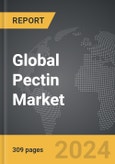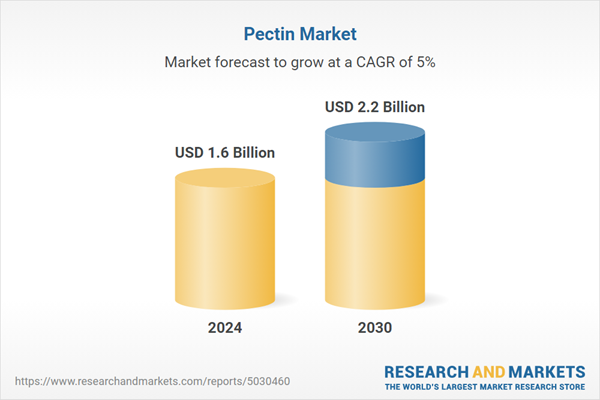Global Pectin Market - Key Trends & Drivers Summarized
How Are Technological Innovations Enhancing the Pectin Market?
Technological innovations have greatly influenced the production and application of pectin, a natural polysaccharide extracted from fruits such as apples and citrus peels. Pectin is widely used as a gelling agent, stabilizer, and thickener in the food and beverage industry, especially in jams, jellies, and dairy products. Recent advancements in extraction technology have made it more efficient to produce high-quality pectin from a variety of fruit sources, increasing yield while minimizing waste. Techniques such as enzymatic extraction and ultra-filtration are improving the purity and functionality of pectin, allowing manufacturers to tailor its properties to specific applications, such as low-sugar or reduced-fat formulations. Additionally, advances in encapsulation technology are enabling the use of pectin in more complex formulations, including pharmaceuticals and nutraceuticals, where pectin's gel-forming capabilities are leveraged for controlled release of active ingredients. As demand for clean-label and natural ingredients continues to grow, technological innovations are ensuring that pectin remains a versatile and essential component in both food and non-food industries.Why Is Pectin in High Demand Across the Food and Beverage Industry?
Pectin is in high demand within the food and beverage industry due to its multifunctional properties and its alignment with consumer preferences for natural and clean-label ingredients. As a natural gelling agent, pectin is indispensable in the production of jams, jellies, and fruit-based products, where it helps to create the desired texture and consistency. Beyond its traditional uses, pectin is increasingly being used in a wide range of products, including dairy alternatives, plant-based desserts, and low-sugar products, as it provides a smooth texture and enhances product stability without the need for artificial additives. The growing popularity of plant-based and vegan diets has also driven demand for pectin as a natural alternative to gelatin, which is derived from animal products. Additionally, the use of pectin as a stabilizer in beverages, such as fruit juices and yogurts, is becoming more prevalent as manufacturers seek to improve mouthfeel and suspension properties in natural and organic drinks. With consumers placing a premium on natural ingredients and label transparency, pectin's versatility and plant-based origins are contributing to its rising demand across various food categories.How Are Health and Wellness Trends Impacting Pectin Adoption?
Health and wellness trends are significantly influencing the adoption of pectin in the food and beverage industry, as well as in pharmaceutical and cosmetic applications. Pectin is a natural dietary fiber, and its health benefits, such as improving gut health, reducing cholesterol levels, and supporting weight management, are driving its inclusion in functional foods and supplements. As consumers become more health-conscious and seek out foods that promote digestive wellness, pectin's role as a soluble fiber that can aid in digestion and act as a prebiotic has increased its appeal in high-fiber foods and beverages. Furthermore, pectin's role in low-sugar and sugar-free products is gaining traction, as it can replace sugar's role as a thickening agent in reduced-calorie formulations, catering to the growing market of diabetic and health-conscious consumers. In addition to its health benefits, pectin is also finding applications in the pharmaceutical industry for drug delivery and in cosmetics, where its hydrating and skin-smoothing properties are valued. As health and wellness trends continue to reshape consumer preferences, pectin's natural and beneficial attributes are driving its broader adoption.What Factors Are Driving Growth in the Pectin Market?
The growth in the pectin market is driven by several factors related to consumer demand for clean-label products, technological advancements, and health-conscious trends. One of the key drivers is the increasing preference for natural and plant-based ingredients in food and beverages, as consumers seek products with recognizable and sustainable components. The rise of vegan and vegetarian diets has also contributed to the demand for pectin as a plant-based alternative to gelatin in both food and pharmaceutical applications. Technological advancements in extraction processes have made pectin production more efficient, increasing supply and enabling its use in more innovative products, such as low-sugar and high-fiber formulations. Additionally, the growing awareness of pectin's health benefits, including its role as a dietary fiber that supports digestive health and weight management, is driving its inclusion in functional foods, beverages, and supplements. The expanding application of pectin in non-food industries, such as pharmaceuticals and cosmetics, where it is used for its stabilizing and hydrating properties, is also fueling market growth. As these trends continue to evolve, the demand for pectin is expected to rise, driven by health, sustainability, and technological innovation.Report Scope
The report analyzes the Pectin market, presented in terms of market value (USD). The analysis covers the key segments and geographic regions outlined below.- Segments: End-Use (Food & Beverage, Bakery, Dairy Products, Pharmaceuticals, Other End-Uses).
- Geographic Regions/Countries: World; United States; Canada; Japan; China; Europe (France; Germany; Italy; United Kingdom; Spain; Russia; and Rest of Europe); Asia-Pacific (Australia; India; South Korea; and Rest of Asia-Pacific); Latin America (Argentina; Brazil; Mexico; and Rest of Latin America); Middle East (Iran; Israel; Saudi Arabia; United Arab Emirates; and Rest of Middle East); and Africa.
Key Insights:
- Market Growth: Understand the significant growth trajectory of the Food & Beverage End-Use segment, which is expected to reach US$904 Million by 2030 with a CAGR of 5.8%. The Bakery End-Use segment is also set to grow at 3.7% CAGR over the analysis period.
- Regional Analysis: Gain insights into the U.S. market, valued at $429.7 Million in 2024, and China, forecasted to grow at an impressive 8.7% CAGR to reach $511.7 Million by 2030. Discover growth trends in other key regions, including Japan, Canada, Germany, and the Asia-Pacific.
Why You Should Buy This Report:
- Detailed Market Analysis: Access a thorough analysis of the Global Pectin Market, covering all major geographic regions and market segments.
- Competitive Insights: Get an overview of the competitive landscape, including the market presence of major players across different geographies.
- Future Trends and Drivers: Understand the key trends and drivers shaping the future of the Global Pectin Market.
- Actionable Insights: Benefit from actionable insights that can help you identify new revenue opportunities and make strategic business decisions.
Key Questions Answered:
- How is the Global Pectin Market expected to evolve by 2030?
- What are the main drivers and restraints affecting the market?
- Which market segments will grow the most over the forecast period?
- How will market shares for different regions and segments change by 2030?
- Who are the leading players in the market, and what are their prospects?
Report Features:
- Comprehensive Market Data: Independent analysis of annual sales and market forecasts in US$ Million from 2024 to 2030.
- In-Depth Regional Analysis: Detailed insights into key markets, including the U.S., China, Japan, Canada, Europe, Asia-Pacific, Latin America, Middle East, and Africa.
- Company Profiles: Coverage of players such as Archer Daniels Midland Company, B&V srl, Cargill, Inc., CP Kelco, Devson Impex Pvt., Ltd. and more.
- Complimentary Updates: Receive free report updates for one year to keep you informed of the latest market developments.
Some of the 13 companies featured in this Pectin market report include:
- Archer Daniels Midland Company
- B&V srl
- Cargill, Inc.
- CP Kelco
- Devson Impex Pvt., Ltd.
- DuPont Nutrition & Health
- FMC Corporation
- Herbstreith & Fox GmbH
- Kerry Group PLC
- Koninklijke DSM NV
- Naturex SA
- Palsgaard A/S
- Tate & Lyle PLC
- TIC Gums, Inc.
This edition integrates the latest global trade and economic shifts into comprehensive market analysis. Key updates include:
- Tariff and Trade Impact: Insights into global tariff negotiations across 180+ countries, with analysis of supply chain turbulence, sourcing disruptions, and geographic realignment. Special focus on 2025 as a pivotal year for trade tensions, including updated perspectives on the Trump-era tariffs.
- Adjusted Forecasts and Analytics: Revised global and regional market forecasts through 2030, incorporating tariff effects, economic uncertainty, and structural changes in globalization. Includes historical analysis from 2015 to 2023.
- Strategic Market Dynamics: Evaluation of revised market prospects, regional outlooks, and key economic indicators such as population and urbanization trends.
- Innovation & Technology Trends: Latest developments in product and process innovation, emerging technologies, and key industry drivers shaping the competitive landscape.
- Competitive Intelligence: Updated global market share estimates for 2025, competitive positioning of major players (Strong/Active/Niche/Trivial), and refined focus on leading global brands and core players.
- Expert Insight & Commentary: Strategic analysis from economists, trade experts, and domain specialists to contextualize market shifts and identify emerging opportunities.
Table of Contents
Companies Mentioned (Partial List)
A selection of companies mentioned in this report includes, but is not limited to:
- Archer Daniels Midland Company
- B&V srl
- Cargill, Inc.
- CP Kelco
- Devson Impex Pvt., Ltd.
- DuPont Nutrition & Health
- FMC Corporation
- Herbstreith & Fox GmbH
- Kerry Group PLC
- Koninklijke DSM NV
- Naturex SA
- Palsgaard A/S
- Tate & Lyle PLC
- TIC Gums, Inc.
Table Information
| Report Attribute | Details |
|---|---|
| No. of Pages | 309 |
| Published | December 2025 |
| Forecast Period | 2024 - 2030 |
| Estimated Market Value ( USD | $ 1.6 Billion |
| Forecasted Market Value ( USD | $ 2.2 Billion |
| Compound Annual Growth Rate | 5.0% |
| Regions Covered | Global |









